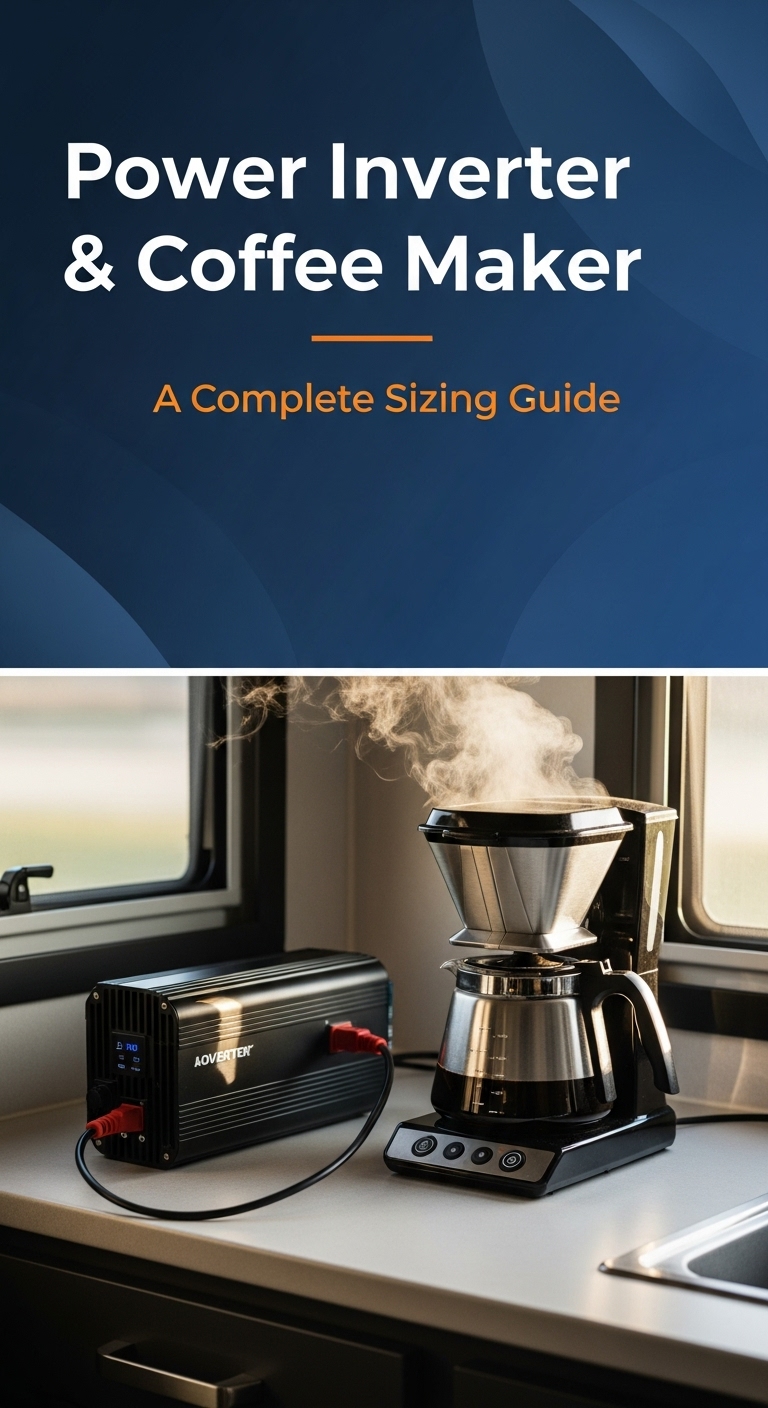As an Amazon Associate CoffeeXplore.com earns from qualifying purchases.
Power Inverter & Coffee Maker: A Complete Sizing Guide
That fresh-brewed coffee aroma shouldn’t be limited to your kitchen. For anyone in an RV, on a boat, at a campsite, or working off-grid, the question of brewing a proper cup of coffee is a top priority. But it immediately raises a critical technical question: can a power inverter run a coffee maker without draining your batteries or damaging your equipment?
Yes, a 1000-watt power inverter can run many common household coffee makers (typically 600-800W), but its success depends entirely on the coffee maker’s specific wattage, its starting power surge, and the type of inverter used. This isn’t a simple plug-and-play situation, and getting it wrong can lead to a tripped system and no coffee.
Leveraging extensive analysis of power requirements and system capabilities, this guide unpacks the proven methods and critical insights you need. We’ll go beyond the simple “yes” to show you exactly how to size your system, understand the hidden power demands of your coffee machine, and choose the right components for a perfect off-grid brew every time.
Key Facts
- Wide Wattage Range: Coffee makers have vastly different power needs, typically ranging from 550 watts for small models to over 1500 watts for high-end espresso machines.
- The Surge is Real: Appliances with heating elements, like coffee makers, create a high initial power surge that can be double their running wattage, a critical factor that often trips undersized inverters.
- Sizing is Key: A 1000W inverter is generally sufficient for standard drip coffee makers (600-800W), but a 2000W model is often necessary for power-hungry Keurig or espresso machines.
- Type Matters Most: Pure Sine Wave inverters are the expert-recommended choice for coffee makers, providing stable, grid-quality electricity that prevents damage and ensures reliable operation.
- Efficiency Loss is a Factor: An inverter is not 100% efficient. You must account for a 10-15% power loss, meaning a 1000W inverter realistically delivers only about 900W of usable power.
The Quick Answer: Can a Power Inverter Run a Coffee Maker?
Yes, a 1000-watt power inverter can run many common household coffee makers (typically 600-800W), but it depends entirely on the coffee maker’s specific wattage, its starting power surge, and the type of inverter used.
Based on an analysis of multiple power sources and appliance specifications, the consensus is clear. A 1000W inverter is capable of powering many standard drip coffee makers and some lower-wattage single-serve machines. However, it is often insufficient for more powerful units like espresso machines or large Keurig models, which demand more power than it can continuously supply.
But why isn’t it a simple yes for every setup? Let’s dive into the details.
Understanding the #1 Factor: Coffee Maker Wattage vs. Inverter Power
A coffee maker’s power need isn’t one number; you must account for both its continuous running wattage (550W-1500W) and its initial starting surge, which can be double its rating. Answering the question “can a power inverter run a coffee maker?” starts and ends with understanding these two critical numbers and matching them to your inverter’s capabilities.

Here’s the bottom line:
- Continuous Operating Wattage: This is the power your coffee maker uses while it’s actively heating water and brewing. Your inverter’s continuous rating must be higher than this number. For example, to run an 800W coffee maker, you need an inverter with at least 800W of continuous power, and ideally more to provide a safety buffer.
- Starting Power (or Surge Power): This is the massive, brief burst of energy an appliance needs to kick its components into gear—specifically the heating element. This surge can be much higher than the running wattage. Your inverter’s peak or surge rating must be able to handle this spike.
Pro Tip: Always check the label on your coffee maker for its exact wattage. It’s usually on the bottom or back of the appliance. Don’t guess!
Running Watts: The Continuous Power Draw
Different types of coffee makers have vastly different power appetites. A small drip machine is a world away from a high-pressure espresso maker. Based on established data, typical power consumption breaks down like this:
| Coffee Maker Type | Typical Wattage Range | 1000W Inverter Feasibility |
|---|---|---|
| Household Drip Coffee Makers | 600W – 800W | Good. Generally sufficient. |
| Capsule Coffee Machines | 900W – 1200W | Marginal. Lower-power models may work, but many will overload it. |
| Espresso Machines | 1000W – 1500W | Poor. Almost always requires a larger inverter (1500W+). |
As the table shows, drip coffee makers (600-800W) are usually fine, while espresso machines (1000-1500W) often require a larger inverter. This is the first and most important check you need to make.
Surge Watts: The Hidden Power Spike
Here’s where many people get into trouble. They match an 800W coffee maker with a 1000W inverter and wonder why it immediately shuts off. The culprit is the surge.
Think of it like a sprinter off the blocks—they need a huge burst of energy just for a second before settling into a steady pace. Your coffee maker’s heating element does the same thing.
- When you turn on a coffee maker, the heating element demands a huge instantaneous current to get up to temperature quickly.
- This initial demand is the “surge” or “peak” power.
- Most quality inverters have two ratings: a continuous rating (e.g., 1000W) and a peak rating (e.g., 2000W). The peak rating can only be sustained for a few seconds.
- Here’s the key: A 1000W inverter might have a 2000W peak capacity. If your coffee maker’s surge is less than 2000W, it will work. If the surge is higher, the inverter’s overload protection will trip, and it will shut down or beep.
An inverter’s peak power (e.g., 2000W for a 1000W model) must be higher than the coffee maker’s initial power surge to avoid tripping the system.
Beyond Watts: 3 Other Critical Factors for Success
Success requires a Pure Sine Wave inverter for stable power, factoring in 10-15% efficiency loss, and ensuring your battery has enough capacity to handle the load. Wattage is king, but if you ignore these three factors, your off-grid coffee station is destined for failure.
Quick Fact: An inverter’s efficiency loss (10-15%) means a 1000W inverter only delivers about 900W of usable power. This missing power can make all the difference!
-
Inverter Type: Pure Sine Wave vs. Modified Sine Wave
Not all inverters are created equal. The type of electrical waveform they produce is critically important for appliances with sensitive electronics or heating elements, like a coffee maker. Always choose a Pure Sine Wave inverter for a coffee maker to ensure stable operation and prevent potential damage to the appliance.
Here’s a quick comparison:
Feature Pure Sine Wave Modified Sine Wave Best For Sensitive electronics, heating elements, motors, all appliances. Simple tools, basic lighting (non-LED). Stability Clean, grid-quality power. Ensures appliances run correctly. “Blocky,” stepped waveform. Can cause buzzing, overheating, or damage. Cost More expensive. Cheaper. For a coffee maker, using a modified sine wave inverter is a gamble. It can cause the heating element to work inefficiently, lead to instability, and potentially shorten the lifespan of your appliance. A pure sine wave inverter is the expert-recommended choice for clean, reliable power.
-
Battery Capacity: The Fuel in Your Tank
Your inverter is just a converter; the real power comes from your batteries. A coffee maker is a power-hungry device, and you need to ensure your battery bank can handle the high draw.
Pro Tip: If you’re using your vehicle’s battery, always run the engine while making coffee to let the alternator help carry the heavy load. This prevents draining your starting battery.
To figure out if you have enough juice, you can use a simple formula. Use the formula (Battery Ah × Battery V) / Inverter W = Run Time (hours) to ensure your battery can sustain the coffee maker’s high power draw.
Let’s look at a real-world example:
- Your setup: You have a single 12V, 100Ah battery.
- Your load: You’re running a 1000W coffee maker.
- The calculation:
(100 Ah × 12 V) / 1000 W = 1.2 hours - The reality: This calculation is for a full load until the battery is completely dead, which you should never do. In practice, a 10-minute brew cycle will consume a significant chunk of your usable battery capacity. Regularly checking your battery status is crucial.
-
System Integrity: Cables and Ventilation
Finally, the supporting components of your system are just as important for safety and efficiency. Overlooking them can lead to power loss or dangerous overheating.
- Cable Quality: High-wattage appliances pull a lot of current. You must use thick, properly gauged cables to connect the inverter to the battery. Undersized cables will get hot, cause a significant voltage drop (reducing performance), and can be a fire hazard.
- Ventilation: Inverters generate a lot of heat when working hard, like when powering a coffee maker. Ensure your inverter is installed in a location with plenty of airflow and is not in direct sunlight to prevent it from overheating and shutting down.
Use thick, properly gauged cables and ensure good ventilation to prevent power loss and inverter overheating.
To equip your setup for success, finding the right components is key. Choosing a high-quality pure sine wave inverter and robust low wattage coffee maker designed for these applications can simplify the entire process and guarantee a great cup of coffee.
FAQs About Powering a Coffee Maker with an Inverter
Here are answers to some of the most common questions people have when trying to figure out if a power inverter can run a coffee maker.
What size inverter do I need to run a coffee maker?
Check your coffee maker’s wattage label. For most drip models (600-800W), a 1000W-1500W pure sine wave inverter is a safe bet. For high-power Keurig or espresso machines (1200W+), you’ll need a 2000W inverter or larger to handle both the continuous draw and the startup surge. Always oversize your inverter slightly to ensure a reliable safety margin.
Will a 2000 watt inverter run a coffee maker?
Yes, a 2000-watt inverter is more than sufficient to run almost any household coffee maker, including power-intensive models like Keurigs and espresso machines. A 2000W inverter can comfortably handle the 600-1500W load of a coffee machine and has plenty of peak power capacity to manage the initial surge without issue.
Will a 400 watt inverter run a coffee maker?
No, a 400-watt inverter is not powerful enough to run a standard coffee maker, as their minimum power requirement (around 600 watts) is too high. A 400W inverter is designed for small loads like charging laptops, phones, or running small fans. Attempting to run a coffee maker on it will immediately trigger the overload protection.
What is a good low wattage coffee maker for an inverter?
Look for smaller 4-cup drip coffee makers, some single-serve “hotel models,” or dedicated 12V coffee makers, as they typically have the lowest power draw. These appliances are specifically designed for environments with limited power, like RVs or trucks, and are much easier for a moderately sized inverter system to handle.
Why does my inverter beep when I try to run my coffee maker?
Your inverter is likely beeping due to an overload error. This is caused by the coffee maker’s initial power surge exceeding the inverter’s peak capacity, or a low battery that cannot supply enough voltage under load. First, check that your battery is fully charged. If it is, the issue is almost certainly that your coffee maker’s surge requirement is too high for your inverter’s peak rating.
Final Summary: Your Blueprint for Brewing Coffee Off-Grid
You now have the complete blueprint to confidently answer the question: can a power inverter run a coffee maker? It’s not just about a single piece of equipment, but about creating a balanced system where your inverter, coffee maker, and battery all work in harmony. By moving beyond a simple wattage number and considering the complete picture, you can build a reliable setup.
Here are the most critical takeaways for success:
* Check the Label: Your coffee maker’s wattage is the most important piece of data. Find it on the appliance label first.
* Prioritize Peak Power: Ensure your inverter’s peak wattage rating is high enough to handle the coffee maker’s hidden startup surge.
* Choose Pure Sine Wave: Always select a Pure Sine Wave inverter to protect your appliance and ensure clean, stable power.
* Don’t Forget the Battery: Your battery bank must have enough capacity to handle the high power draw without being excessively drained.
* Mind the Details: Use thick cables and ensure good ventilation to maintain efficiency and safety.
Now you have the complete blueprint. Check your appliance, size your system, and enjoy that perfect cup of coffee, wherever you are
Last update on 2025-12-15 / Affiliate links / Images from Amazon Product Advertising API

